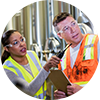Using Onsite Medical Expertise to Recruit Skilled Employees
In this webinar, you will learn about:
- Staffing shortages rippling through industries
- How COVID-19 virus fears are reducing job applications
- How on-site programs can help ease virus fears
- Vital components of on-site program success
- What on-site programs mean for recruitment and retention
Presented by:
Giovanni Gallara, MPT, PT
Executive Vice President
Chief Clinical Services Officer
Michael Rhine, DPT, PT
Senior Vice President
Chief Operating Officer - Onsites
Opening
0:00-1:15
Hello, and welcome to the Concentra® webinar, Using On-site Medical Expertise to Recruit and Retain Skilled Employees. Today’s webinar will be presented by Giovanni Gallara and Michael Rhine.
Giovanni Gallara is executive vice president and chief clinical services officer, overseeing Concentra Therapy, Concentra Advanced Specialists, Referrals and Ancillary Services, Medical Review, and Pharmacy programs. He’s led Concentra in advancing injury recovery and efficient workers’ compensation case closure since joining the company in 2011.
Mike Rhine is senior vice president and chief operating officer of onsites health programs business unit, overseeing the operations of Concentra’s more than 130 on-site clinics. He has extensive experience in health care and strong knowledge of emerging workers’ compensation and legislative issues affecting occupational health care.
At the conclusion of the presentation, we will have a 10-to-15 minute Q-and-A session with Giovanni and Mike. You can submit your questions throughout the presentation to be answered during the Q and A. They will answer as many questions as possible within the time allowed. A recording of the webinar will be e-mailed to you after the presentation, as well as a copy of the slides, so you can view it again at your convenience.
Giovanni, Mike, we're ready to begin.
Giovanni Gallara
Agenda
1:16-3:48
Great. Thank you.
Good afternoon, folks. This is Giovanni Gallara. First, I want to thank everybody for joining. I know it’s a Friday afternoon here in August, so, I appreciate your spending some time with us this afternoon. Hopefully, you take away some good information from the presentation.
Before we go into the agenda items, what we’ll do is start with two really high-level themes, as far as what the goal of the presentation is, and these will be supported by the agenda items that you see in front of you.
So, at a high level, what we’re going to try to do is paint the current employment landscape and discuss some of the drivers in the workforce right now that are prohibiting folks from potentially returning to work.
Second, we’re going to shed some light on the continued impact of COVID-19.
On that one major theme, we’re going to talk about how the importance and focus on employee health and safety could be a huge opportunity for employers and your customers potentially to drive better workforce participation and support business objectives.
The second big theme is leveraging on-site care to drive better workforce health and supporting not only the health and wellness of employees but also, again, meeting the needs of business objectives in a way that’s cost-affordable and value-added to the employees.
So, with the agenda, we have six items.
We’ll talk through the drivers of the skilled labor shortages. We’ll address work health concerns of employees, specifically around COVID-19, and other occupational health and safety concerns. We’ll walk through how to create a safer workplace with an on-site program that is tailored to employer needs. Number four, we will incorporate components of successful on-site programs, focusing on employer engagement and successful partnership with the medical provider. Five, we will discuss how to make on-site medical support affordable. Then, six, we’ll paint a compelling business case for the use of on-site care, and then we’ll follow-up with some question-and-answer. So, next slide.
The Rise of Skilled Labor Shortages
3:49-8:30
Next, I will set the stage and provide some background on the current employment landscape. On the left side of the slide, you see information provided monthly by the US Bureau of Labor Statistics, specifically the Job Openings and Labor Turnover Survey. If you take a look at the top number, from March to May, job openings were well over nine million per month. In June of this year, the number of job openings rose to over 10.1 million, which was a new record.
So, job openings are often a sign of a strong economy, which currently, as we’re recovering through COVID-19, is a positive scenario for the U.S. economy.
The challenge is, currently the volume of hiring is not meeting the demand of job openings. On the right side of the slide, you can see a U.S. Chamber of Commerce report, specifically, the America Works report that says across diverse industries, including construction, health care and hospitality, 76 percent of those respondents were extremely concerned with regards to the difficulty in recruiting, the current employee value that’s needed to run their respective businesses. Next slide.
What we’ll show here is really a tale of two stories. If we can think back to May 2020, we’ll focus on the total private and government lines, the hiring levels in May of 2020 were 8.3 million versus the job openings in the light blue mark at 5.4 million. Fast-forward to May 2021, and we see those ratios almost reversed, meaning much lower hiring levels, with an overwhelming, larger volume of job openings. And, again, if you think about your respective industries, some of your colleagues in other industries, and if you read on the news, there’s definitely a shortage of employees across multiple industry types. We’re seeing that very clearly in the U.S. Bureau of Labor Statistics report.
We will also present June information, and that’s the next slide here. Again, very similar; the ratios have gotten slightly better in June, but you can see still what we saw earlier, in reference to that 10.1 million job opening number, compared to the 6.7 million hiring levels. So, again, the race for skilled employees is definitely out there, and what we’ll talk through next, the next slide here, is potentially the impact of what happens when you have a shortage of skilled labor.
We’ll take the construction industry as our example. This information comes from two sources. Construction Executive in May of 2020 and also the U.S. Chamber of Commerce Commercial Construction Index. The key takeaways are here.
Eighty percent of polled contractors were highly concerned with jobsite safety due to a lack of skilled employees. I think the second bullet here is really important. This comes out of the U.S. Chamber of Commerce. Nearly 35 percent of new, untrained employees in construction are injured in their first year. So, from a workers’ comp occupational health employer claims professional, those are some pretty stunning statistics when you think about the potential impact to our patients, our customers, and employees.
The big takeaway is there is absolutely business impact to the lack of skilled employees in the workforce and, specifically, in addition to the heightened safety risk and potential claims cost, there are also inefficiencies in business objectives and business management, as well, without having the right folks in the right place in the workforce.
Work Health Safety Concerns of Employees
8:37-15:26
Next, we’re going to talk about what the workforce is telling us regarding some of the concerns with willingness to return to the workplace. Indeed.com did a survey of 5,000 unemployed adults, ages 18 to 64. They found was that COVID-19 and COVID vaccination rates are a key driver in their willingness to return to work. Again, that’s been substantiated with some other resources, as well. So, if you think about your own personal industries, I’m just getting an appreciation of the percentage of your colleagues or family members who are vaccinated. There is a handful of folks in the workplace that is not comfortable with where we are from a vaccination standpoint, and that’s potentially prohibiting their willingness to enter the job force.
The next slide will give you some detailed information here. Again, these are continued results from the Indeed survey. The two biggest drivers for motivating folks or allowing folks that level of comfort to return into the workforce, are really driven by the five categories you see in front of you. But we’re going to focus on increased vaccination.
If you take a look at college degreed employees versus less than a college degree, you can see both are pretty vocal about increased vaccinations being the key driver for returning to the workplace. Then, the second category is more job opportunities. So, again, thinking about our employers out there, the willingness to improve vaccination rates is going to be a key component of getting folks comfortable with returning into the workplace. Next slide.
There is a potential dilemma, however, if you take a look at the four resources we have here. There is a percentage of the workforce reporting throughout these polls – ranging from 14 to 25 percent – of American adults who say that they’re not willing to get vaccinated. So, again, that could create potential challenges for those folks in the workforce that are waiting for higher levels of vaccination, where their peers or community members, ranging from 14 to 25 percent, say they will never get vaccinated for various reasons.
So, where does occupational health support come in here?
In this month’s Construction Executive, there was an article published specifically on utilizing on-site occupational health experts to foster dialog to overcome vaccine hesitancy and to provide vaccine clinics to overcome health care access, issues, or concerns.
If you think about a potential workforce, whether it’s for your own employees or potentially a customer that you serve, partnering with the right occupational health provider to provide education and access to the vaccine could be a huge windfall to (a) increase health and safety at the worksite and (b) also to demonstrate to potential employees that the safety and concern of incoming employees is paramount.
On a side note, another consideration is also to understand – and this comes from a diversity, equity, and inclusion perspective – and it’s to really understand the makeup of your workforce. A University of Pennsylvania identified that minority groups have a higher level of vaccine hesitancy than the general population. What they found essentially was, if community members of minority groups can partner with either employers or health care providers, then there’s a higher level of vaccine acceptance in community members when there is embracing of diverse groups with health care providers. So that is an opportunity to truly understand, whether you’re an employer or working with an employer, to really ask those questions to understand who makes up that employee population and, in addition to medical expertise, are there other alternatives in partnership to ensure that we’re reaching diverse groups across the continuum. Next slide.
There are additional health and wellness concerns outside of COVID-19. There are two major ones here. One is folks who have had COVID in the past. I am sure most of you have heard of the term “long haulers.” The ability to partner with an on-site provider to address some of these long haul needs helps ensure that their return to work is safe, and also that there is a plan to address some of the deconditioning associated with long haulers.
When you think about the volume of folks that have been out of the workforce – and we can all probably relate to this – there’s a certain part of our lives over the past 14 to 24 months where our activity level might not have been what it usually is or accustomed to be because of the lockdowns and so forth.
So, if you’re out of the workforce, and you want to come back to a physical job but you basically haven’t functioned at that activity level, there’s a role that the on-site medical provider can play, as far as creating conditioning programs and ensuring a safe return to work. Next slide.
Before I hand it off to Mike, the goal here was to provide a little bit of background. What Mike is going to present is how the on-site medical clinics can address some of these concerns, how they can be a solution for some of the hesitancy and the unwillingness to return to the workforce – and potentially what that looks like from a specificity standpoint. How do you tailor an on-site program to meet the goal of the employer’s business objectives and those of the specific employee base they’re trying to recruit and retain? So, Mike. I’ll hand it off to you.
Mike Rhine
Creating a Safer Workplace with an On-site Program
15:27-19:52
Thanks, Giovanni. I appreciate the handoff and the great context you provided.
An on-site program can be a very powerful catalyst, and that’s because they’re embedded in your business and they should be embedded in your culture. It demonstrates that employee health is a top priority of the business.
Employees and job seekers who can know their health and safety will be supported in this way are likely to regard your company more positively than others at this time due to virus fear, yet we’re also seeing that COVID has forced us to put their health and safety in much higher regard. That’s a trend that we expect to continue. Next slide.
The on-site clinic can be designed to provide an entire spectrum of health care services from one provider to a full-blown medical center of diagnostics, X-ray, and ultrasound services. The two major areas are occupational medicine and primary care. Both of these models usually provide some sort of urgent care services, as well, for walk-ins for your general aches and pains, not feeling well, not necessarily related to a primary care clinic condition or an occupational-related injury or physical need.
Our focus tends to lean toward occupational medicine. The three lines of service that are most popular are:
- Pre-employment screening, which includes pre-placement physicals and functional testing, all to assess if the job candidate can perform the essential functions of the job without safety risk to self or others.
- Overseeing employee safety and injury prevention, such as workplace health promotion. It also includes clinicians providing evidence-based guidance to protect workforce safety, as well as vaccinations, possible vaccine boosters, and symptom identification and management.
- Providing injury care. This includes onsite clinicians’ medical care and physical therapy, depending on physical staffing. Injury prevention, again, is a key component for this service, as well. Our ultimate goal would be to prevent the injury from happening in the first place. If additional services are needed, we have our national footprint of nearly 520 medical centers that we can leverage, and we have an integrated technology/EMR system with them. That allows doctors who are not on-site and embedded in the organization to know what the employee is going through, if they would have a reason to go to our centers for one reason or another. That usually depends on the size of the on-site, and we’ll discuss that a little later in the presentation.
There are more than 130 Concentra onsites nationwide. Concentra onsites supported employer and employee needs during the pandemic in a number of ways. Some of those examples include:
- Our clinicians provided employers informed, evidence-based information and guidance on protocols, vaccinations, and safety.
- They managed cases, calmed fears, and provided guidance to employees when they were exposed to COVID-19 or suspected exposure.
- Our clinicians put employees at ease through their presence in the workplace and easy access to them through Concentra Telemed®.
Early on in the pandemic, we were able to pivot to keep symptomatic employees out of the workplace but still provide them with treatment and guidance they needed by the clinicians they knew through our telemedicine option, which proved very valuable. Our clinicians took steps to preserve employee health and function, both COVID- and non-COVID-related. We have anecdotal evidence that demonstrates how our on-site clinicians diagnosed primary care needs. We were also able to get some folks help for diagnoses to save them and keep them going in vital functions at work.
Overall, it provides a unique opportunity to address employee needs across a wide spectrum of services.
Components of Successful On-site Programs
19:53-25:01
On-site programs aren’t a “plug and play” out-of-the-box option. “If you have x employees, this is what you want to do, or if you are in this industry, this is what you should be doing.” They do require collaboration between the employer and the on-site provider.
There are four vital components of on-site success.
- Structural approach. An on-site program needs to be embedded into the business. We’ll talk about this a little bit later.
- Buy-in. An on-site must have the buy-in and ongoing support of the company’s senior and site leadership to be successful.
- Collaboration. Company leadership and the on-site team must work together to establish and meet on-site program objectives.
- And finally, success is more obtainable when you choose an on-site provider that aligns with your company standards and culture, and we’ll talk a little bit about how we do that.
On-site programs are embedded in the business. This may be the most key point in helping to ease virus fear and instill confidence that employee health and safety will be protected. An on-site program sends a message that employee health and safety are valued.
More importantly, the on-site medical team builds the relationship and trust with the employees. It’s not okay to just put an on-site into an office or into a location. That on-site team needs to build the relationship with the patients and have the support of both the site and the corporate leadership.
In a way, they’re able to create a “medical home” that provides a point of access for all of the care needs. In an occupational medicine model, there may be specialty care outside the four walls of the on-site, and we’re able to steer or guide that, help the patient navigate through that process in most states.
During workers’ compensation cases, an on-site clinician keeps the injured employee and employer connected and provides a sense of being one team and getting them back to function. When we’re on-site and embedded, the employee knows we understand what they’re doing every day at their job because the on-site clinicians spend time on the floor. They do a post-injury assessment, whether there’s an RN or an athletic trainer or other medical clinicians. There’s a trust there. It’s an outside provider but they’ve actually seen what the employee is doing. That’s important in the return-to-work process. It really helps decrease that time from injury to return to normal work. Next slide.
Executive leadership is eager for consistent, ongoing medical guidance. We’ve seen, with the rise of the Delta variant and potentially other variants, real-time accurate health information and guidance are highly valued and very likely will be for some time to come. Leadership and on-site clinicians must be well-integrated to make sure they are aligned, not just on COVID-related goals but also the key performance indicators that drive success of their program outside of COVID: safety, injury prevention, wellness, timely treatment, and exceptional patient care.
Many companies are now considering on-site programs to address pandemic-related employee health care needs but the benefits go way beyond just COVID. Next slide.
So, why is collaboration with leadership so important? Working together and communicating effectively promotes employee engagement and utilization of the on-site clinic to be successful. Both teams have to work together to drive utilization of the on-site center. Building value through buy-in, participation, alignment, and support of all parties can help meet goals, show concern for employees, and help calm not only virus fear, but general health and workplace medical needs.
Finally, an on-site should align well with the company’s standards and culture. At Concentra, we do this in several ways. We clearly outline a collaborative scope of work prior to launching an on-site. We also provide “cultural fit” interviews for all of our on-site colleagues. Then, we follow that up, after implementation, with quarterly stewardship reviews and meetings to go ahead and make sure we are truly meeting the objectives.
Obviously, this happens more frequently in times of crisis like we have experienced for the last year and a half. Through this process, we get a deep understanding of the business and allow the on-site to shift over to what’s happening, as applicable. We can build relationships with the workforce, the leaders, and ultimately achieve the exceptional medical outcomes that the clients and patients are looking for. Next slide.
Making On-site Medical Support Affordable
25:08-31:18
We’ve said a lot about on-sites. Now, we want to take a step back and talk about how an on-site does not have to be a heavily staffed, fully functioning clinic with diagnostics, as I mentioned earlier.
At Concentra, an on-site program can be configured to serve your business needs and budget. There are many options in size, services, and staffing – ranging from a single on-site nurse, ATC, or even just a medical director to that full-service clinic I mentioned. One very popular option is the athletic trainer-led on-site program, with the athletic trainer filling multiple roles, such as:
- Promoting musculoskeletal health through exercise programs
- Injury prevention and ergonomics
- Providing injury treatment. When appropriate, using knowledge of first aid to help you avoid an OSHA recordable.
Next, we’re going to go through a couple slides that will show you some options based on scale.
The first option would be for smaller businesses, with 500 to 1,000 employees. Staffing can involve a registered nurse or athletic trainer, based on needs and services. And the list of possible services you see here is long. But as I mentioned before, both athletic trainers and nurses can triage work injuries.
Athletic trainers are a little more geared toward injury prevention and ergonomic assessments that can be highly needed in the manufacturing industry or injury prevention on jobsites, construction sites. The registered nurse tends to lean more towards first aid treatment, doing some of the occupational clinical testing, and case management.
These programs tend to have a smaller footprint as you see in the floor plan description. A lot of times, it can be run with one exam room or sort of treatment area and the bathroom. Next slide.
We’ll go up a little more in size and talk about 1,000 to 2,000 employees. Staffing can include a nurse practitioner, possibly a medical assistant, depending on volume, which will allow clinicians to do more clinical stuff. Still consider a registered nurse, athletic trainer, or possibly a health coach, depending on the scope and what is needed. Then, you start to add to your scope of services, urgent care, and work injury treatment, as well as limited primary care with the addition of the nurse practitioner. The wellness services can be done by the nurse in both situations.
So, you start to grow into a full occupational health model. The nurse practitioner can work with either an athletic trainer or physical therapist, depending on, again, the skills and what option provides a full scope of work injury treatment.
Now for the medium floor plan, you typically need a waiting room in this model or a waiting area, some sort of admitting area, and then usually around two to three exam rooms, and a lab collection areas, as well.
On the next slide, companies with larger workforces will find their best value in a full clinic. And the reason why is that we can provide more services, and with more opportunities to pull levers to provide that return on investment from a financial perspective, as well as integrate more deeply with the culture.
So, this is where you consider adding a physician and a physical therapist. The other staffing options will be dependent on scope and size. Again, you're looking at adding physical therapy and continue with all of the other items we had before, and a chronic condition management falls under the primary care umbrella, as well.
These offices are usually larger, 2,000 square feet or more, again, a waiting room, front desk, three or four exam rooms. And when you have an employer this size, you start to look at the hours. You may have a clinician there for a set block of hours, but then you'll have a nurse and the athletic trainer, who may cover additional hours to give you more of an 8-to-5 or 9-to-5 sort of coverage. We start looking at the evenings and weekends. We do that in the smaller models as well. But depending on when the populations are coming through, and how do we touch most employees, I think that really goes to the scope of work meeting, when we begin working with senior leadership to set the goals for the on-site. Next slide.
As Giovanni mentioned, job seekers and the skilled labor you need are wary of returning to the workplace as COVID-19 and Delta variant cases rise. All indications are that this goes beyond COVID-19, and the expectations of job seekers have shifted to more of a health focus.
Occupational health experts are uniquely equipped to support you with evidence-based medical knowledge, overcome virus fear, builds confidence, and demonstrate that the employer is committed to employee health and safety. We're also there to help with vaccination as well as the testing options for the COVID vaccine where that is an option.
With more than 30 years of experience providing on-site care and our 40 years of occupational health experience, Concentra knows what it takes to achieve an on-site program success and how to work with you to make it happen.
We offer multiple programs and configurations to meet your needs, and our on-site programs have demonstrated throughout the pandemic how our clinicians were able to ease employees’ fears, raise their confidence about being at work and enable them to be focused on work and be productive.
So, if any of you are interested, obviously, don't wait. You can reach out to either Giovanni or me today. Now, we're happy to take some of your questions about the webinar. And we do appreciate your time on this Friday afternoon. We hope that it's helpful to you.





